A medieval curved sword from the early 14th century has been discovered in a ruined monastery on the northwest Aegean coast 40 miles southeast of Thessaloniki. It was unearthed in an excavation of the ruins of Agios Nicolaos Chrysokamaros, a small fortified dependency of the Saint George the Zograf Monastery on Mount Athos just across the bay. Very few late Byzantine swords have been found in Greece, and this is the only one to have been unearthed by archaeologists in its original undisturbed archaeological context.
The 14th century was a turbulent time on the Chalcidice peninsula, primarily due to conflicts between the Latins and the Byzantine Empire. The Catalan Grand Company, Aragonese mercenaries initially engaged by the Byzantine emperor who would later double-cross them, spent a solid two years between 1307 and 1309 sacking the monasteries on Mount Athos. Incursions by Turkish pirates, Balkan potentates seeking to chip away at Byzantine territory and the growth of Ottoman power kept the Aegean coast in constant turmoil. There were 300 monasteries on Mount Athos in 1300. By the end of the 1300s, there were only 35 still standing.
The sword is heavily corroded and incomplete with a surviving length of 18 inches. It has a single edge and is curved throughout its full length. It was bent and burned in the raid that destroyed the monastery outpost. Several of the metal rings from the scabbard fused to the blade. They are the only part of the scabbard to survive.
This type of saber was used by both Byzantine and Turkish soldiers, so it’s difficult to know who wielded this weapon before it was buried.
[Excavation leaders] Maniotis and Dogas have identified three military actions in the 14th century that could have led to the sword being used there: attacks along the coast by Turkish pirates, which included the kidnapping in 1344 of administrators from the Mount Athos monastery; the occupation of the region from 1345 until about 1371 by the forces of the Serbian king Stefan Dušan, who aspired to conquer Byzantine territories in the West; and the siege of Thessalonica by Ottoman troops from 1383 until 1387, when the Chalkidiki region was often raided for food.
Maniotis can’t say for sure, but he thinks the sword may be of Turkish origin, and that it was used in a pirate raid on the monastery.
 The excavation has revealed that the monastic outpost was very well fortified indeed, encircled by a granite block wall more than six feet thick. The tower was used as a shelter for villagers during military attacks and pirate raids, and to keep important religious relics and food stores safe. Evidence of severe fire damage was found in the same archaeological layer as the curved sword, indicating the tower was set alight in a raid.
The excavation has revealed that the monastic outpost was very well fortified indeed, encircled by a granite block wall more than six feet thick. The tower was used as a shelter for villagers during military attacks and pirate raids, and to keep important religious relics and food stores safe. Evidence of severe fire damage was found in the same archaeological layer as the curved sword, indicating the tower was set alight in a raid.

